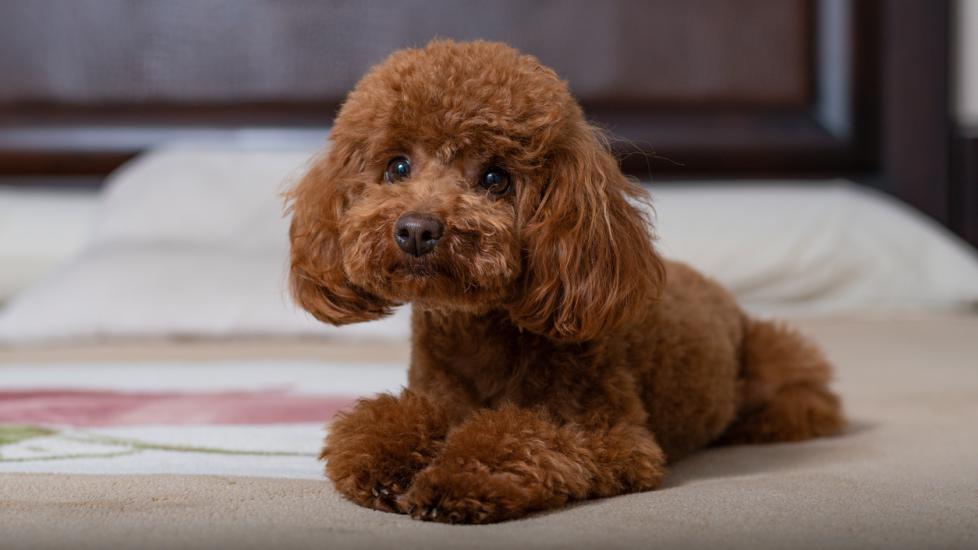Toy Poodle
iStock/servando Juvera
The Toy Poodle is one of the smartest dog breeds—as well as one of the most entertaining. Despite standing no more than 10 inches tall and weighing 4–6 pounds, the Toy Poodle has a big, playful personality that can fill up a room.
While frequently associated with France, Standard Poodles were first developed in Germany, where they were used in duck hunting. Toy and Miniature Poodles have been bred down from the larger Standard Poodle, according to The Poodle Club of America.
Caring for a Toy Poodle
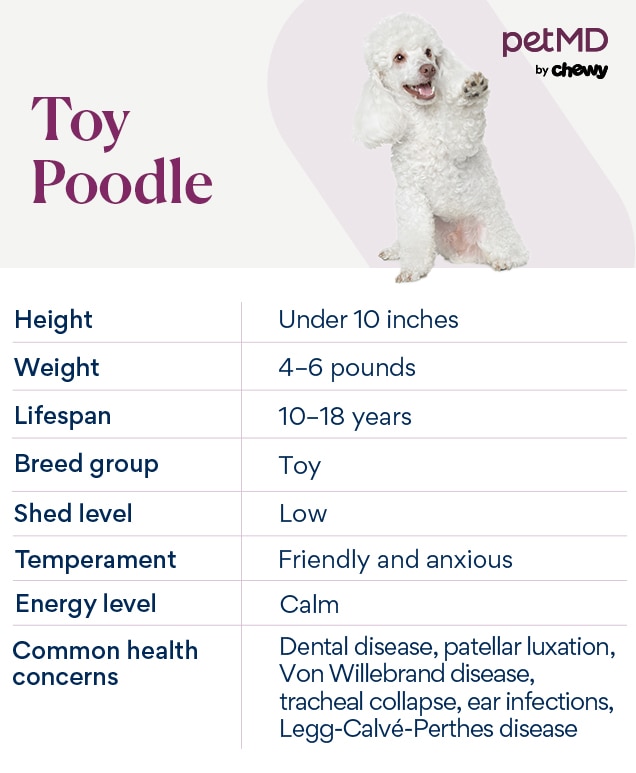
Toy Poodles aren’t just adorable; they make wonderful family pets. They’re exceptionally intelligent and eager to please, making them easy to train. They have lower exercise needs than many other dog breeds, but they still benefit from a daily walk and at-home play sessions.
Poodles of all sizes have curly coats with extensive grooming needs. Their coat grows continuously, calling for a trim every four to six weeks.
Toy Poodles also don’t shed much, so they can be a smart choice for some people with allergies. However, there is no such thing as a completely “hypoallergenic” dog. People with allergies should spend time with the breed before officially bringing home a Toy Poodle puppy.
Toy Poodle Health Issues

The typical Toy Poodle lifespan is 10–18 years, and they’re a healthy breed overall. But during this long life, they are predisposed to a few health issues that may require care. Pet parents may benefit from investing in pet insurance early in their Toy Poodle’s life.
Reputable Toy Poodle breeders will screen their dogs for many of these conditions so they produce healthy puppies.
You can gain more insight into your Toy Poodle’s health by screening them for over 230 genetic health conditions with a dog DNA test.
Progressive Retinal Atrophy
Progressive retinal atrophy (PRA) is a group of diseases that cause a breakdown of the photoreceptor cells (rods and cones) on the retina. Initially, the dog may have difficulty seeing in the dark, but the condition can cause blindness over time.
PRA is an inherited disease and there are currently no effective treatments available.
Patellar Luxation
The patella (kneecap) is a small bone that normally sits in a groove within the femur (thigh bone) at the knee. In dogs with patellar luxation, the patella moves (luxates) outside of its assigned groove when the knee is flexed. This abnormal movement can cause discomfort and may eventually lead to arthritis.
Many pets will skip or run on three legs when the patella is out of place. While some cases will correct themselves, in more severe cases the patella remains out of place.
In mild cases, joint supplements (such as fish oils and glucosamine), anti-inflammatory medications, weight management, and diet changes are used to control pain and minimize arthritis. In more severely affected dogs, surgery may be recommended.
Legg-Calve-Perthes
Legg-Calve-Perthes disease is a condition in which the head of the femur (thigh bone) breaks down, likely secondary to lack of blood supply. This causes pain and limping.
Legg-Calve-Perthes occurs in young dogs, mostly in Toy Poodle puppies less than 18 months old. In some cases, pain can be controlled with medications. In severe cases, surgery to remove the head of the femur may be recommended.
Ear Infections
Ear infections in dogs occur when there’s an overgrowth of yeast and/or bacteria in the ear. Symptoms include visible debris, redness, odor, head shaking, and scratching.
Take your dog to the veterinarian for an exam if any of these signs are noted. In most cases, ear infections can be resolved by cleaning the ear with vet-approved ear cleaners, giving your dog prescription medication, and identifying the underlying causes of the infection (allergies).
Toy Poodles develop ear infections more often than most other breeds. This may be partly due to Poodles having long ear canals with excess curly hair to trap in moisture and debris. Trimming (not plucking) the hair from the ear may help reduce the incidence of ear infections.
Dogs with chronic or recurring ear infections frequently have allergies that should be addressed.
Dental Disease
Dental disease is one of the most common conditions seen in dogs, especially in small breeds like the Toy Poodle. Dental disease occurs when tartar and plaque build up. This leads to bacterial infection of the tissues around the teeth and under the gumline—and eventually to tooth and bone decay.
Daily tooth brushing with a dog-specific toothpaste is the best way to prevent dental disease, though some diets, treats, and chew toys also help prevent plaque and tartar.
Routine dental cleanings are recommended to evaluate your dog’s mouth, remove plaque and tartar, polish the teeth, and treat or extract teeth that are significantly unhealthy. Dental disease is a painful condition and may even affect the health of your Toy Poodle’s internal organs.
Tracheal Collapse
Tracheal collapse occurs when the trachea (commonly called the windpipe) flattens. This happens due to weak cartilage rings or the sagging of a membrane along the trachea.
Symptoms include a dry cough, which can worsen when your Toy Poodle eats or when she’s excited. Most cases are treated using medications, but in severe cases where breathing is impeded, surgery may be necessary.
Toy Poodles are likely genetically predisposed to tracheal collapse. To prevent and manage this condition, it’s important to keep your dog at a healthy weight. When on walks, use a harness or a no-pull head-collar instead of attaching a leash to your dog’s collar, as pressure on the trachea can cause further damage.
Von Willebrand’s Disease
Von Willebrand’s Disease (vWD) is a genetic blood disorder often seen in Toy Poodles. The condition causes a deficiency in a protein called the von Willebrand factor, which is necessary for platelets to stick together and form a clot.
In dogs that are deficient in this protein, the blood may have difficulty clotting, which can lead to bleeding from the nose, vulva, bladder, or gums. Additionally, dogs with this condition may bleed for a long time after trauma or surgery.
Because some dogs with VWD do not have notably prolonged bleeding until later in adulthood, blood levels of von Willebrand factor can be measured to help with diagnosis. Most veterinarians recommend testing for VWD prior to any planned surgery, including spays, neuters, and dewclaw removals.
What To Feed a Toy Poodle
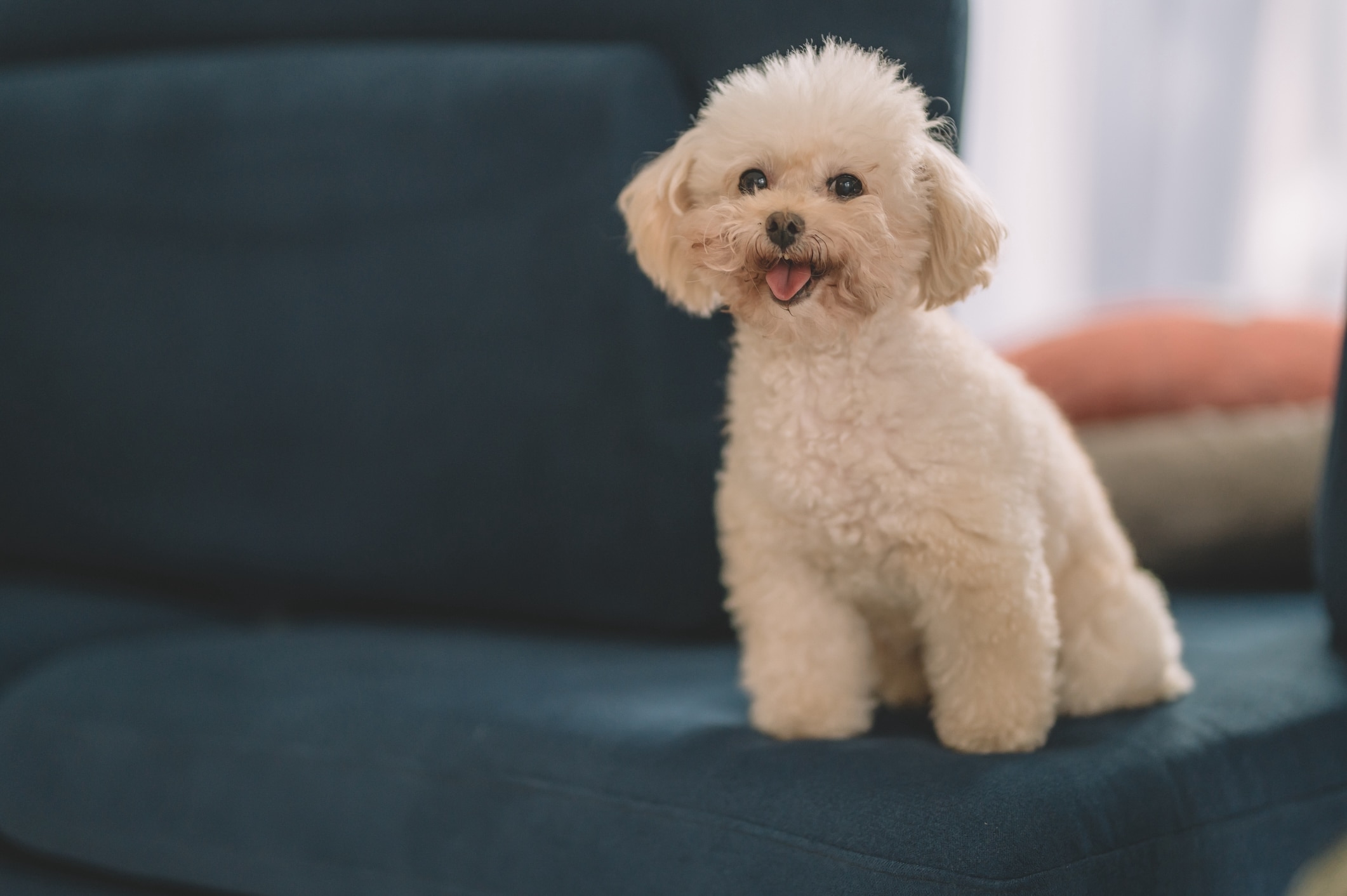
Feeding a commercial kibble or wet food that meets the nutritional standards set by the Association of American Feed Control Officials (AAFCO) is a good way to ensure that your Toy Poodle receives a complete and balanced diet.
Puppies should be fed a diet formulated specifically for puppies or designated for all life stages. For Toy Poodle adults, dental-focused diets may be recommended by your veterinarian to help prevent dental disease.
Talk to your vet about the best food for your dog. Some brands, including Royal Canin, even make dog food just for Poodle puppies and adult dogs.
How To Feed a Toy Poodle
Because Toy Poodles are small dogs, they will do well with two to three feedings per day. Toy poodle puppies, however, should eat three to four small meals per day on a consistent schedule to help maintain their blood sugar and prevent hypoglycemia.
How Much Should You Feed a Toy Poodle?
The recommended caloric intake for a Toy Poodle varies from dog to dog and depends on your pup’s physical size, metabolism, neuter status, and activity level. The best way to determine the feeding quantity is to talk with your veterinarian, who can calculate your Toy Poodle’s caloric needs.
Additionally, the feeding guide labels on the dog food provides valuable information for pet parents. Just remember: In small breeds like the Toy Poodle, calories in treats add up quickly.
Treats should only make up 10% of your dog’s daily diet. The other 90% should come from dog food.
Nutritional Tips for Toy Poodles
Some Toy Poodles may benefit from omega-3 fatty acids (DHA/EPA) added to their diets.
Omega-3 fatty acids can be found in skin and joint supplements, fish oil, and even in some specially formulated dog foods. These fatty acids act as natural anti-inflammatories that help support the skin, coat, kidneys, joints, and heart.
Behavior and Training Tips for Toy Poodles
Toy Poodle Personality and Temperament

As a breed, Toy Poodles are exceptionally intelligent and eager to please their family. They are playful and self-confident when socialized at a young age.
While relatively calm, Toy Poodles enjoy playtime and exercise with the family. The breed is gentle with other pets and children, though all interactions between dogs and kids should be supervised. Because these pups are so tiny, they can accidentally be hurt during playtime.
Toy Poodles have lower exercise needs than many other dog breeds, but they still benefit from a daily walk and play session.
Toy Poodle Behavior
Toy Poodles bond closely to their families and may develop separation anxiety if left alone for extended periods. They can also be sensitive to stress, and sudden changes in the home environment may lead to gastrointestinal upset.
Additionally, because all Poodles are so smart, they need mental stimulation to keep themselves entertained—and out of trouble. Bored dogs are more likely to bark, jump, and be destructive.
Keep your Toy Poodle busy with interactive playtime, toys, and training sessions.
Toy Poodle Training
Toy Poodles want to please their pet parents. Paired with their smarts, this makes them an easy breed to train.
As always, training is most successful when based on positive reinforcement with praise and tasty treats. But make sure you’re not overfeeding them with treat rewards!
Fun Activities for Toy Poodle
Toy Poodle Grooming Guide
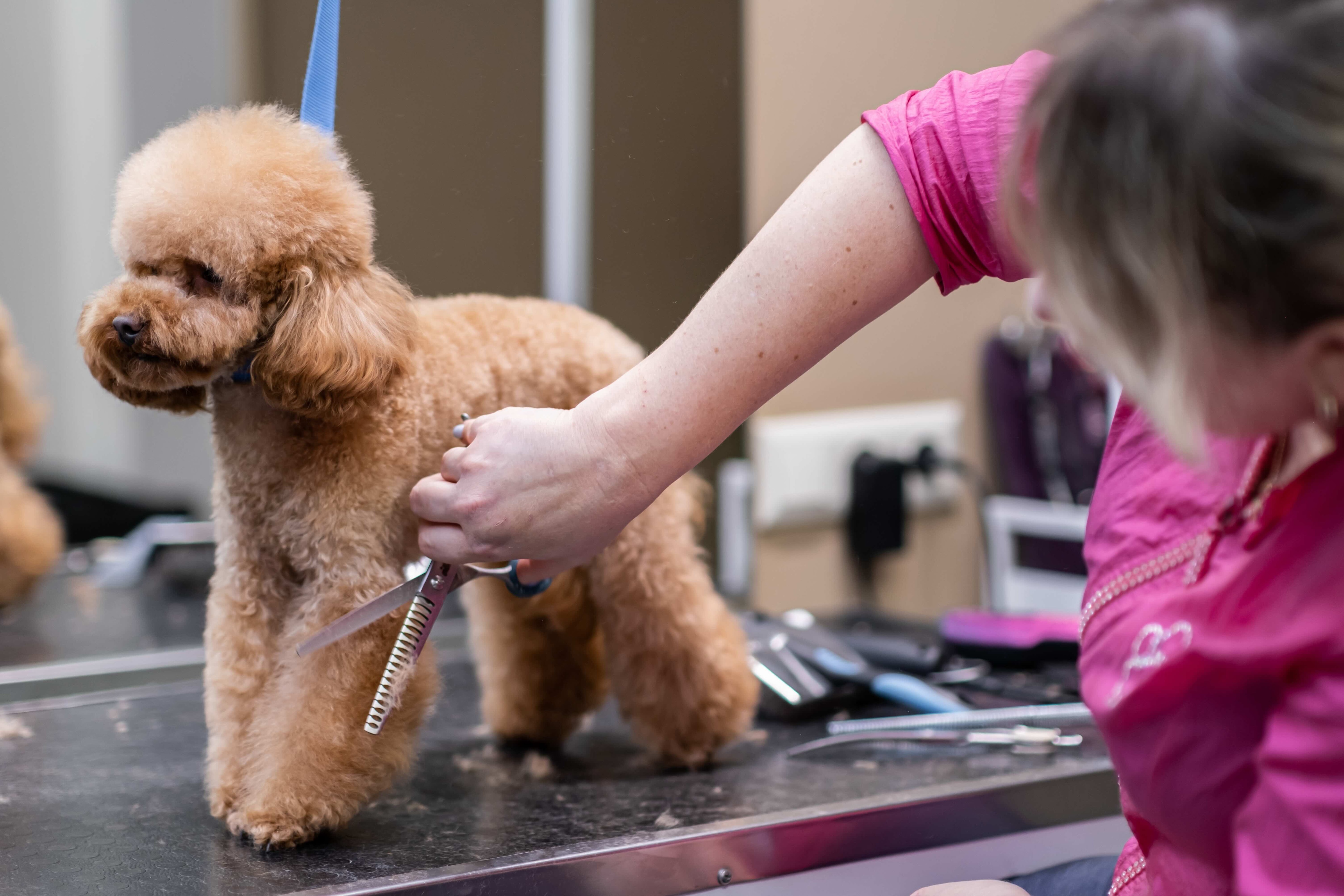
All Poodle sizes have hair (not fur!) that grows throughout life and sheds very little. But that hair is dense and mats easily, requiring routine care.
Skin Care
Most Toy Poodles should be bathed every two to four weeks, but your vet may recommend more frequent bathing depending on your dog’s health and any underlying medical conditions. A gentle, dog-specific shampoo and conditioner work well on their curls.
Coat Care
Unless your Toy Poodle’s coat is groomed very short, it’s important to brush their hair daily to prevent matting. The hair needs to be detangled all the way to the roots.
Originally, Poodles were groomed with the classic Continental clip for hunting. This style limited the amount of heavy hair that had to be carried, while still protecting important parts of the body from cold weather and water. This Poodle haircut is less common in house pets today, as the short “puppy cut” requires less home care.
No matter what haircut your Toy Poodle has, most need to be professionally groomed every four to six weeks.
Eye Care
Wiping your Toy Poodle’s eyes daily with a soft, moist cloth or vet-recommended eye cleaner will help remove debris. Some Poodles are prone to heavy tear staining around the eyes, but rinsing the corners of the eyes daily with saline can help prevent this.
Hair around your Toy Poodle’s eye should be carefully trimmed to keep it from causing irritation. If squinting or eye discharge is noted, take a trip to the veterinarian for an exam, as these can be signs of more serious eye conditions.
Ear Care
Toy Poodles often develop ear infections due to allergies. To prevent these, clean your dog’s ears every week or two, as directed by veterinarian, and keep the ear hairs trimmed (not plucked). Redness, odor, or debris may indicate an infection, and you should consult your veterinarian.
Considerations for Pet Parents
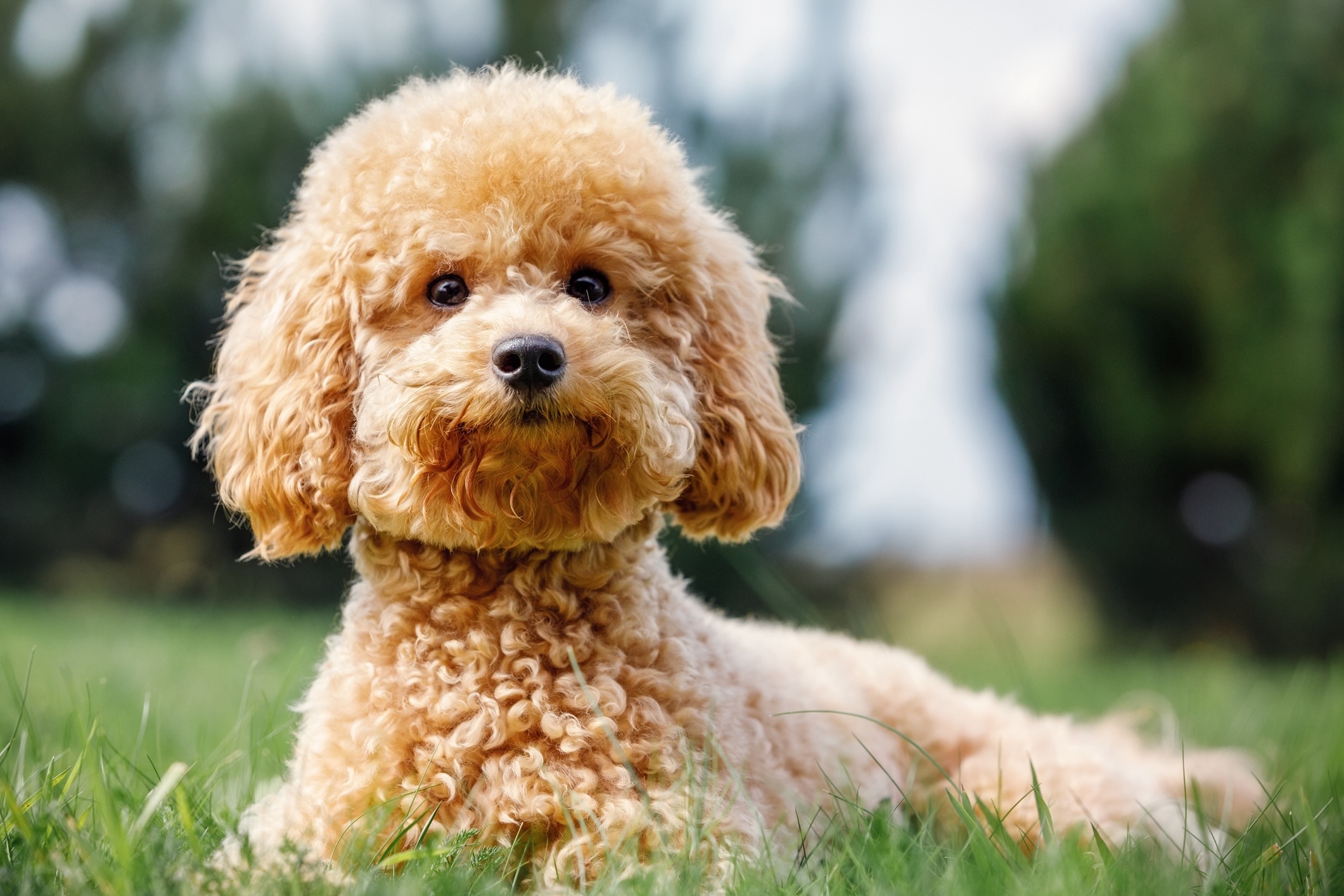
Toy Poodles make wonderful pets for nearly any family—as long as you dedicate time and money to grooming.
They are extremely intelligent and eager to please, which makes them easy (and fun!) to train with treats and praise. Their intelligence also means they require a lot of mental stimulation via activities like scent walks, puzzle toys, and obedience training.
When socialized early in life, most Toy Poodles are gentle with children and pets.
Toy Poodle FAQs
Do Toy Poodles shed?
No, Toy Poodles shed very little. Despite this, they need near-daily grooming for their high-maintenance coat.
Are Toy Poodles hypoallergenic?
No dog is 100% hypoallergenic, but Toy Poodles have a reputation for being good pets for some people with pet allergies.
Are Toy Poodles good house dogs?
Yes, Toy Poodles are exceptional pets due to their impressive intelligence and good nature. They are relatively easy to train and do well with small children, if socialized early.
How much is a Toy Poodle?
Purchasing a Toy Poodle puppy from a breeder can cost between $1,200–$3,000. Dogs of certain lineage may cost more. Poodles and Poodle mixes can also be found in rescues and shelters.
How big does a Toy Poodle get?
A Toy Poodle, full-grown, is typically no more than 10 inches tall and weighs between 4–6 pounds.
Do Toy Poodles bark a lot?
Yes, Toy Poodles have a reputation for barking a lot. Keeping your dog entertained with mental stimulation and exercise can help reduce excess barking.
What is the difference between Standard Poodles, Miniature Poodles, and Toy Poodles?
The main difference between the three types of Poodles is size:
-
Standard Poodles are over 15 inches tall and weigh 40–70 pounds.
-
Miniature Poodles are 10–15 inches tall and weigh 10–15 pounds.
-
Toy Poodles are no more than 10 inches tall and weigh only 4–6 pounds.
